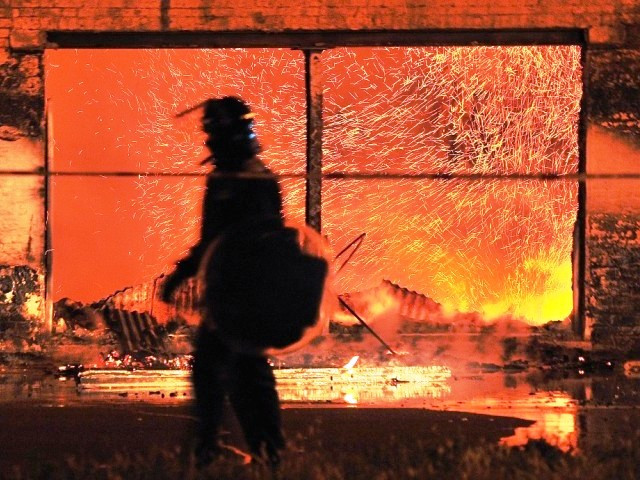Last summer Britain's Coalition government introduced the strongest budget cuts in England in decades. To rein in debts, 77 per centof the consolidation was to come from spending cuts compared to only 23% by increasing taxation; with its approval lawmakers had lit the match that would set Britain on Fire.
The killing of 29-year-old Mark Duggan last week in Tottenham - by officers of the Met Police's Gun Control Wing - resulted in a Protest for Justice on Saturday. By nightfall the mostly black youth of Tottenham, had turned violent.
Over 6000 people claim jobless benefits in Tottenham, the highest unemployment rate in London. One fifth are under 24. The situation in the rest of England is on average only half as bad.
Britain’s Austerity drive has, additionally, robbed the youth of "cohesion instruments" like sports, libraries, dance and other community activities. The youth services budget saw a 75 per cent cut this year as part of planned budget cuts over the next three years.This has created an environment where young people feel disconnected from the community, and the single most unifying force for the Mob is the gap created between the haves and have-nots.
After a failed attempt at blaming small groups of criminal elements for the copycat riots cropping up in different cities, Politicians have now started blaming mothers and fathers, when in fact, they have only themselves to blame; and yes, social media networking.
The mob moved quickly, from looting Sainsbury's in Camden to Evans Cycles in Chalk Farm. The crowd, a mix of onlookers, thieves, and hooligans, - armed with blackberry's and Smartphone’s, that enabled access to social media websites like twitter & facebook - moved from Hampstead to Kilburn to Holloway, a flurry of updates on Mob movement and that of the Police were riding the internet.
Blackberry's free messenger service was the choice medium for disseminating information on when, where and what they were targeting. Suddenly territorial boundaries that existed for years had vanished, the rioting had unified a cross-section of society that identified with each other, boys, girls, teens, twenty something's and even 10 year olds became one force.
To the rioters this was no less than a carnival - a very loud, violent outing - after a long hot boring summer.
Tweets, Status Updates and Broadcasts invited rioters to the next Target and it seemed everybody wanted to join in. Riots began popping up in all corners of England - Birmingham, Bristol, Oxford, Manchester, Liverpool, Enfield, in London; Clapham, Croydon, Ealing, Brixton, Peckham, and Oxford Circus as well.
As the hash tag #LondonRiots became #UKRiots, the PM assured the press and public that the rioters would be dealt with severely. The police numbers in the capital more than doubled to a massive 16000 police force.
Even with increased security in London, residents elsewhere in Britain complained that the Police was only protecting corporations and not the small businesses.
To protect their own, many area's witnessed the community coming out to protect themselves. The Turks were the first to chase away the Rioters, Tweets about Muslims protecting the properties of non-Muslims in East London were flooding timelines. In Southall the Muslims prayed in the Mosque's while the Sikh stood guard outside; the community came together with Muslims and Hindu’s standing United.
Just as social media networks were labeled as 'responsible' for the unrest, Blackberry and Twitter also paved the way for #RiotCleanup's which brought together thousands of young Britons to clean up the mess as early as 9am in the morning.
While the attention it seemed was on London, a new fire was about to erupt in Birmingham where three Pakistani's after standing guard at the local mosque were returning to protect their properties on Dudley Road in Winson Green.When Muhammed Shakeel let his friends Haroon Jahan, 21, and two brothers, Abdul Musavir, 31, and Shahzad Ali, 30, out of his car; no one could have imagined that they were about to meet their maker.
According to eyewitness accounts, a speeding car with a black youth behind the wheel sped right at them, running over the three friends. Eyewitnesses recalled how the Police, when it arrived, was more interested in harassing them, than in helping the injured.
The factors responsible for these riots have, thus, become clear. The widening gap, between the rich and poor, as well as that which exists between the community and the police are equally responsible for the unrest; but most importantly it is the absence of productive activities that would otherwise keep the youth engaged.
Even if cuts in the youth services budget are reversed, this alienation will continue to exist. Jobs are scarce and while the youth have skills they remain unemployed. If employment opportunities are not created, and unemployment rates continue to rise, the future will hold many more nights when cities will be in flames.
Why London burned again
If employment opportunities are not created, the future will hold many more nights when cities will be in flames.



COMMENTS
Comments are moderated and generally will be posted if they are on-topic and not abusive.
For more information, please see our Comments FAQ